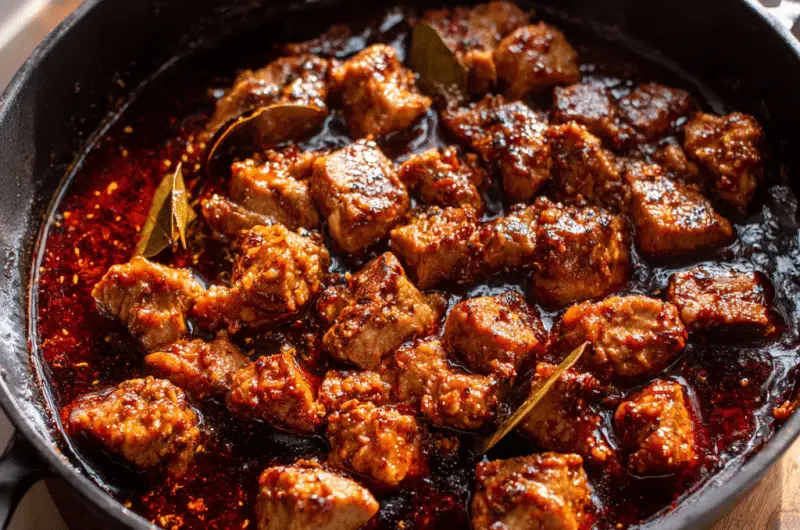Introduction: The Soul of Mexican Comfort Food
The authentic Receta Mexicana de Adobo de Puerco has been the cornerstone of my family’s Sunday dinners for over fifteen years, transforming simple pork shoulder into a deeply flavorful, tender masterpiece that brings everyone together around the table. This traditional Mexican dish represents everything I love about authentic Mexican cuisine – bold flavors, simple ingredients, and cooking techniques passed down through generations that create something truly magical.
When I first learned this Receta Mexicana de Adobo de Puerco from my neighbor Carmen, who immigrated from Guadalajara thirty years ago, I had no idea how profoundly it would change my approach to cooking pork. The combination of dried chiles, aromatic spices, and slow-cooking techniques creates layers of flavor that transform even the toughest cuts of meat into fork-tender perfection. Whether you’re new to Mexican cooking or looking to perfect this classic dish, this authentic recipe will become your go-to method for creating restaurant-quality adobo at home.
Understanding the Magic Behind Authentic Mexican Adobo
Before diving into the recipe itself, it’s essential to understand what makes authentic Mexican adobo so special and why this particular preparation method has remained unchanged for centuries. The word “adobo” comes from the Spanish verb “adobar,” which means to marinate or preserve, and this dish represents the perfect marriage of indigenous Mexican ingredients with Spanish cooking techniques.
The Foundation: Dried Chiles and Their Complex Flavors
The heart of any authentic Receta Mexicana de Adobo de Puerco lies in the careful selection and preparation of dried chiles. Each variety contributes distinct flavors, heat levels, and colors that create the signature deep red sauce that defines this dish:
Chiles Guajillo: These provide the beautiful deep red color and mild, sweet flavor with subtle fruity notes. They form the backbone of most adobo sauces and are absolutely essential for authentic flavor.
Chiles Ancho: These dried poblano peppers add rich, complex sweetness with hints of chocolate and raisin notes. They contribute body and depth to the sauce without overwhelming heat.
Chiles Chipotle: Smoked jalapeños that bring moderate heat and an incomparable smoky flavor that elevates the entire dish. Use sparingly – their intensity can quickly overpower other flavors.
The magic happens when these chiles are properly toasted, rehydrated, and blended into a smooth paste that becomes the foundation of your adobo sauce.
Why Pork Shoulder is the Perfect Choice
Traditional Receta Mexicana de Adobo de Puerco relies on pork shoulder (also called pork butt or Boston butt) for several important reasons:
Fat Content: The marbling throughout pork shoulder keeps the meat moist during long, slow cooking while adding incredible flavor to the sauce.
Connective Tissue: The collagen in tougher cuts breaks down during cooking, creating natural gelatin that gives the sauce its silky, rich texture.
Flavor Development: Unlike lean cuts, pork shoulder becomes more flavorful and tender the longer it cooks, making it perfect for this traditional preparation method.
Economic Advantage: Pork shoulder costs significantly less than premium cuts while delivering superior results in braised dishes like adobo.
The Importance of Slow Cooking Techniques
Authentic Mexican adobo cannot be rushed. The slow cooking process allows:
- Tough connective tissues to break down completely
- Flavors to meld and develop complexity
- The meat to absorb the chile-based sauce thoroughly
- The sauce to reduce and concentrate into rich, glossy perfection
This patience-required approach might seem daunting in our fast-paced world, but the results justify every minute spent. Besides, most of the cooking time is hands-off, allowing you to attend to other tasks while your kitchen fills with incredible aromas.
Essential Ingredients for Authentic Receta Mexicana de Adobo de Puerco
Creating exceptional adobo requires understanding how each ingredient contributes to the final dish. Let’s explore what makes this recipe so special and where to find the best ingredients.
Selecting and Preparing Your Chiles
The quality of your dried chiles will make or break your Receta Mexicana de Adobo de Puerco. Here’s what to look for:
Fresh Appearance: Even though they’re dried, quality chiles should be pliable, not brittle. They should have vibrant color and intact skin without excessive dust or broken pieces.
Where to Shop: Mexican markets typically offer the freshest, highest-quality chiles. Many regular supermarkets now carry basic varieties, but specialty stores provide better selection and fresher products.
Storage Tips: Store unused chiles in airtight containers in a cool, dark place. Properly stored chiles maintain quality for up to one year.
Preparation Method: Always toast chiles lightly in a dry pan before rehydrating. This crucial step intensifies their flavors and removes any residual moisture that could cause bitterness.
Choosing the Right Cut of Pork
For the most authentic results, select pork shoulder with these characteristics:
Weight Range: Look for 3-4 pound pieces, which provide the ideal ratio of meat to fat and cook evenly.
Fat Distribution: Choose pieces with good marbling throughout rather than large fat caps on one side.
Bone-In vs. Boneless: Both work well, though bone-in cuts often have superior flavor. Boneless cuts are easier to serve and portion.
Freshness Indicators: The meat should be pink-red in color with white fat and no off odors.
Supporting Ingredients That Make the Difference
Beyond chiles and pork, several ingredients elevate this dish from good to extraordinary:
Mexican Oregano: This is different from Mediterranean oregano, with a more floral, citrusy flavor that complements Mexican cuisine perfectly.
Bay Leaves: Use Mexican bay leaves if available, as they have a more subtle, complex flavor than California bay leaves.
White Onion: The traditional choice for Mexican cooking, providing clean, sharp flavor that doesn’t compete with the chiles.
Roma Tomatoes: These paste tomatoes add body and slight acidity that balances the rich, fatty pork.
Piloncillo or Brown Sugar: Traditional piloncillo (Mexican brown sugar cones) adds complex sweetness, but dark brown sugar works as a substitute.
Step-by-Step Authentic Receta Mexicana de Adobo de Puerco
Now let’s create this magnificent dish that will transport your kitchen to the heart of Mexico.
Ingredients
For the Adobo Sauce:
- 6 dried guajillo chiles, stems and seeds removed
- 4 dried ancho chiles, stems and seeds removed
- 2 dried chipotle chiles, stems and seeds removed
- 3 Roma tomatoes
- 1 large white onion, quartered
- 6 garlic cloves
- 1 teaspoon Mexican oregano
- 1/2 teaspoon ground cumin
- 1/4 teaspoon ground cloves
- 1 teaspoon salt
- 2 tablespoons apple cider vinegar
- 2 tablespoons piloncillo or dark brown sugar
For the Pork:
- 3-4 lbs pork shoulder, cut into 2-inch chunks
- 2 tablespoons vegetable oil
- 2 bay leaves
- 1 large white onion, sliced
- Salt and pepper to taste
- 2-3 cups chicken or beef broth (as needed)
Instructions
- Prepare the Chiles: Heat a large, dry skillet over medium heat. Toast the dried chiles for 30-60 seconds per side until they become fragrant and slightly puffed. Don’t let them burn, as this creates bitterness. Place toasted chiles in a bowl and cover with hot water. Let them soak for 20-30 minutes until softened.
- Char the Vegetables: In the same skillet, char the tomatoes, quartered onion, and unpeeled garlic cloves until they have black spots and are softened. This usually takes 10-15 minutes total, turning occasionally. The charring adds incredible depth to the final sauce.
- Blend the Adobo Sauce: Drain the softened chiles, reserving 1 cup of the soaking liquid. In a blender, combine the chiles, charred vegetables (peel the garlic first), oregano, cumin, cloves, salt, vinegar, and piloncillo. Add 1/2 cup of the chile soaking liquid and blend until completely smooth. The sauce should be thick but pourable. Add more soaking liquid if needed.
- Strain for Perfection: Pass the blended sauce through a fine-mesh strainer to remove any remaining chile skin or seed pieces. This step is crucial for achieving the silky smooth texture that characterizes authentic adobo. Press the solids with the back of a spoon to extract maximum flavor.
- Sear the Pork: Pat the pork pieces dry and season generously with salt and pepper. Heat vegetable oil in a large Dutch oven or heavy pot over medium-high heat. Working in batches to avoid overcrowding, sear the pork pieces until golden brown on all sides, about 8-10 minutes total per batch. Remove pork and set aside.
- Cook the Sauce: In the same pot with the pork drippings, add the strained adobo sauce. Cook for 10-15 minutes, stirring frequently, until the sauce darkens and thickens slightly. The sauce should coat the back of a spoon.
- Combine and Braise: Return the seared pork to the pot along with bay leaves and sliced onion. Add enough broth to barely cover the meat. Bring to a gentle simmer, then reduce heat to low, cover, and cook for 2-3 hours until the pork is fork-tender and easily shreds.
- Final Adjustments: During the last 30 minutes of cooking, remove the lid to allow the sauce to reduce and concentrate. Taste and adjust seasoning with salt, pepper, or a touch more vinegar if needed. The sauce should be thick enough to coat the meat but not dry.
Pro Tip: For even better flavor, prepare this dish a day ahead. The flavors continue to develop overnight, and reheating actually improves the taste and texture.
Serving Suggestions and Traditional Accompaniments
Authentic Receta Mexicana de Adobo de Puerco shines when served with traditional Mexican sides:
Warm Corn Tortillas: Essential for making tacos or simply scooping up the delicious sauce.
Mexican Rice: The neutral flavor provides a perfect base for the rich, complex adobo sauce.
Refried Beans: Creamy beans complement the spicy, smoky flavors beautifully.
Fresh Accompaniments: Diced white onion, chopped cilantro, lime wedges, and crumbled queso fresco add brightness and texture contrast.
Pickled Vegetables: Pickled jalapeños, carrots, and onions (escabeche) provide acidic contrast that cuts through the rich meat.
Troubleshooting Common Adobo Challenges
Even experienced cooks sometimes encounter issues when making this complex dish. Here are solutions to common problems:
Problem: Sauce Is Too Spicy
Solution: The heat level depends heavily on your chile selection and personal tolerance. To reduce heat:
- Remove all seeds and veins from chiles before soaking
- Reduce the number of chipotle chiles used
- Add more tomatoes or a small amount of sugar to balance the heat
- Serve with cooling accompaniments like crema or avocado
Problem: Sauce Is Bitter
Solution: Bitterness usually results from:
- Burning the chiles during toasting (toast more gently next time)
- Not removing all seeds (they can be bitter)
- Over-charring the vegetables (aim for spots, not complete blackening)
- Using old, stale chiles (invest in fresh, pliable ones)
Problem: Meat Is Tough After Long Cooking
Solution: This typically indicates:
- Cooking temperature too high (keep at gentle simmer)
- Insufficient cooking time (some cuts need 3+ hours)
- Wrong cut of meat (lean cuts won’t work well)
- Not enough liquid during cooking (add more broth as needed)
Problem: Sauce Is Too Thin
Solution: Several approaches work:
- Continue cooking uncovered to reduce liquid
- Remove some sauce, simmer separately until thickened, then recombine
- Mix a small amount of masa harina with water to create a slurry, then stir in
Regional Variations and Personal Touches
While this recipe represents a classic approach, different regions of Mexico have their own interpretations of Receta Mexicana de Adobo de Puerco:
Oaxacan Style
Oaxacan versions often include:
- Additional indigenous chiles like chilhuacle negro
- A touch of Mexican chocolate for richness
- Avocado leaves for subtle anise flavor
Yucatecan Influence
In the Yucatan, adobo might feature:
- Achiote paste for color and earthy flavor
- Sour orange juice instead of vinegar
- Different chile varieties native to the region
Northern Mexican Approach
Northern states sometimes add:
- More cumin and oregano for robust flavor
- Beer or wine to the braising liquid
- Different vegetable additions like bell peppers
Personal Customization Ideas
Consider these modifications to make the recipe your own:
- Add chunks of pineapple for sweet-savory contrast
- Include Mexican cinnamon stick during braising
- Experiment with different vinegar types (rice, sherry, or red wine)
- Add root vegetables like carrots or potatoes during the last hour of cooking
Health Benefits and Nutritional Considerations
This traditional Receta Mexicana de Adobo de Puerco offers several nutritional advantages:
Protein Power
Pork shoulder provides high-quality complete protein essential for muscle maintenance and overall health. A typical serving delivers 25-30 grams of protein.
Beneficial Compounds from Chiles
The dried chiles used in adobo sauce contain:
- Capsaicin, which may boost metabolism and reduce inflammation
- Vitamin C, even in dried form
- Antioxidants that support overall immune function
- Minerals like potassium and iron
Collagen and Joint Health
The slow-cooked connective tissues in pork shoulder provide natural collagen, which may support joint and skin









